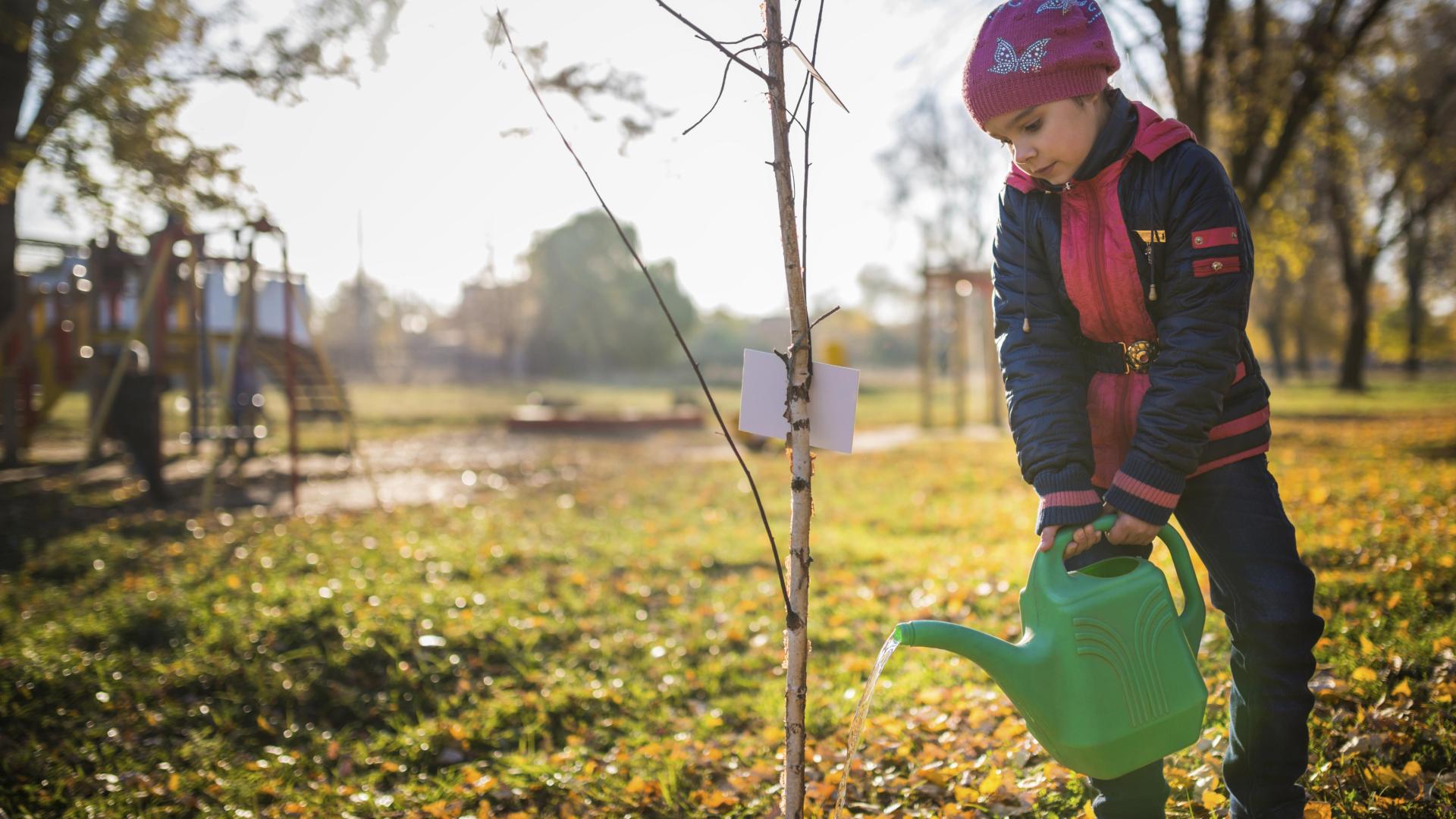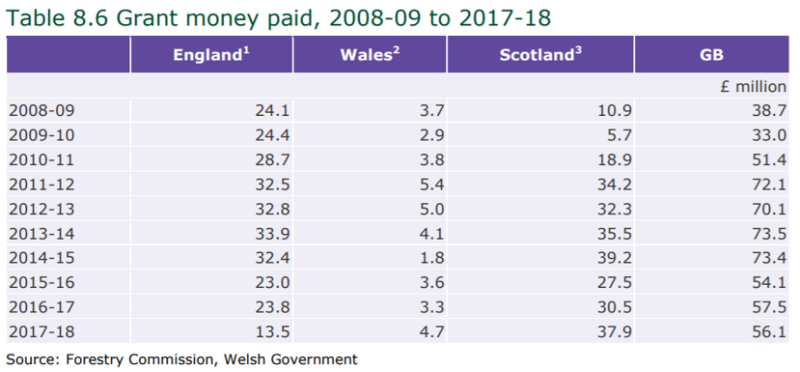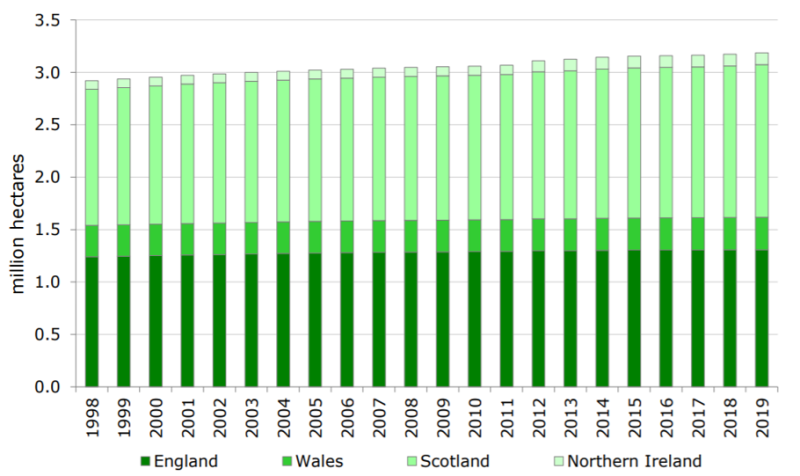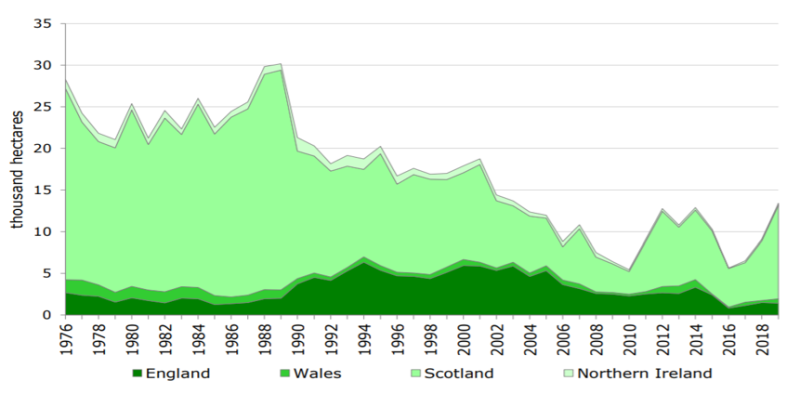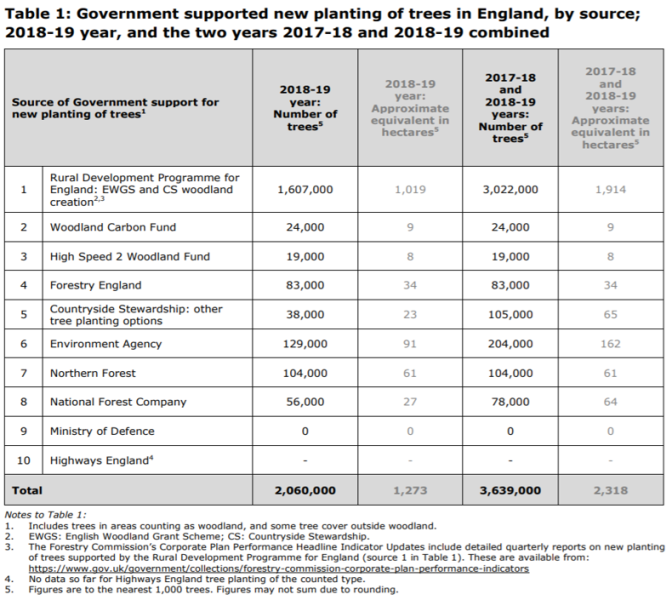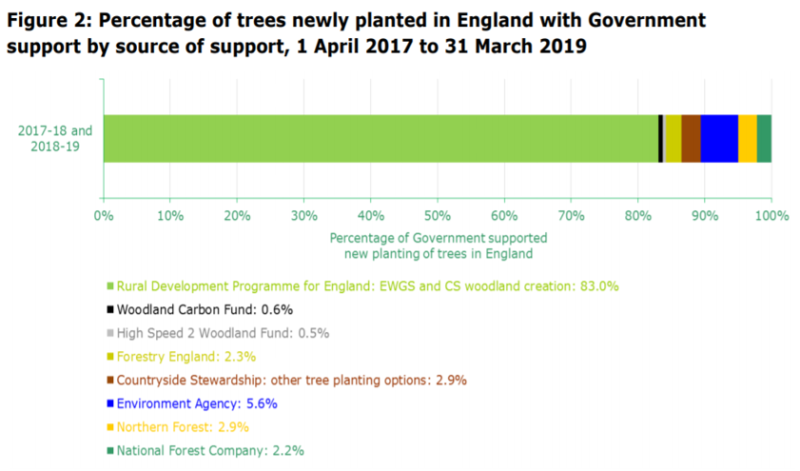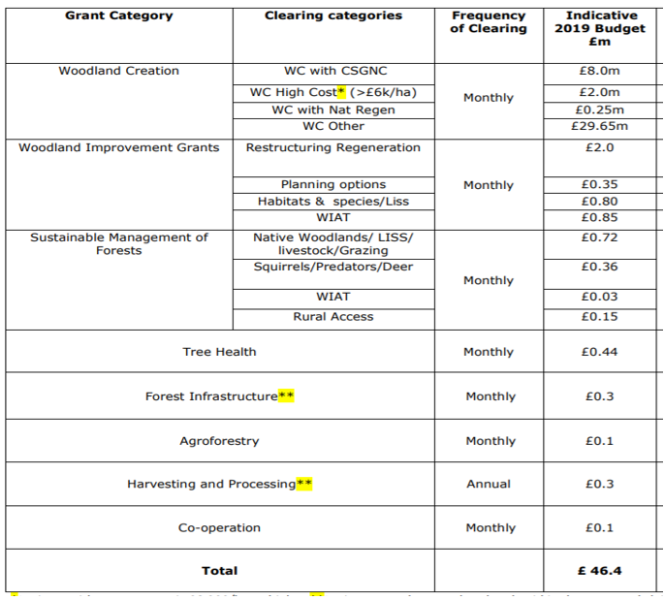Paul de Zylva13 Nov 2019
Executive summary
Public funding for tree planting, woodland creation and forestry has existed in various forms for many years, although levels of tree planting in the UK have been in overall decline for several decades.
Tree planting rates reflect extremely modest funding levels. Most money for tree planting, woodland creation and forestry is distributed by the UK government from EU-related Rural Development and Countryside Stewardship programmes.
In 2017-18, government grant funding for planting and management of trees, woodland and forestry in England, Scotland and Wales fell to around £56 million. Northern Ireland funding pushes that figure closer to £60 million a year.
Even allowing for an increase in Scottish forestry budgets in 2019-20, UK governments are spending less than £1 per person per year on trees.1
Confused funding - Despite the modest amounts of grant funding and tree planting, the funding landscape for trees is opaque, complicated and confusing. It’s difficult to get detailed breakdowns of how much money is being distributed specifically for trees and woodlands under farm subsidies, and many of the grant schemes that are available are hard to discern from one another as they have similar sounding names or aims.
Below, we list the many grant schemes which appear to be available. Where a specific funding amount is known, it’s given; where it’s not been possible to break down funding totals by scheme or agency, there’s a question mark.
MPs on the House of Commons Select Committee on Environment, Food and Rural Affairs have identified that the current operation of the Countryside Stewardship Scheme (CSS) is “not fit for purpose” and is acting as a barrier to greater woodland creation.
In their report, MPs stated:
“The ambition to have 12% woodland cover – only a third of the EU average – in England by 2060 will not be achieved without a fundamental change to the ‘bureaucratic’, ‘overly complex’ and ‘torturous’ delivery system for CSS. In this report we have called on the Government to reinstate a one-stop shop for forestry grants on day one of the UK’s exit from the European Union, which will signify a return to a well-functioning grant system.”2
Future funding - The future of funding for trees is currently uncertain. Apart from the recently introduced 30-year, £50 million Woodland Carbon Fund, current political and funding cycles mean that many funding sources are ending, with existing EU-related agri-environment schemes due to expire in 2021.
Government policy is to continue public subsidies to farmers and landowners under the EU’s Common Agriculture Policy (CAP) until they’re replaced by post-Brexit policies. By 2028 all land-based payments should’ve been replaced by farm payments conditional on positive outcomes for our environment, described as “public money for public goods”.3
Funding for the Forestry Commission and other agencies is likely to continue, but the forms and amounts are uncertain. Tree planting may also be funded from other sources such as the new Environment Land Management Scheme, which will replace direct payments to farmers and landowners, funding for Natural Flood Management and for the Nature Recovery Network proposed for England.
Proceeds from carbon credits and other natural capital valuation and financialisation mechanisms, such as Payments for Ecosystem Services and Biodiversity Net Gain, may also offer up some funding for trees.
Doubling tree cover - For the time being, post-Brexit policies and funding amounts are unclear. Moreover, there’s no certainty that UK policies and funding that replace CAP-related Countryside Stewardship and Rural Development Programmes (RDPs) will be commensurate to the essential task of doubling UK tree cover as part of the UK’s aim to reach net carbon zero and restore nature and ecosystems.
Friends of the Earth estimates that doubling tree cover will require public investment of around £500 million per year4 – around 10 times current government spending on trees. That may sound like a lot, but it’s equivalent to a rounding error in the Treasury’s annual budgets.
The multiple benefits of trees in terms of carbon drawdown and storage, flood mitigation, urban cooling, improved soil and water quality and habitat for wild species, also far outweigh the upfront costs. Faced with the combined climate and nature emergency, we can’t afford not to spend more money on trees.
Funding for trees – an overview
Overall grant funding for tree planting, woodlands and forestry has been declining in recent years, from a modest high point in 2013-14.
The table below by Forest Research shows forestry-related grant funding from 2008-09 to 2017-18 by UK governments in England, Wales and Scotland.5
Even allowing for increased funding in Wales and Scotland, in 2017-18 the total of £56.1 million paid in grants was a 3% decrease from the previous year:
- Wales: £4.7 million in 2017-18, a 41% rise over 2016-17, although this is still lower than the £5 million high point in 2012-13.
- Scotland: £37.9 million in 2017-18, a 24% rise over 2016-17, although this is slightly lower than the high point in 2014-15.
- England: £13.5 million in 2017-18, a 43% decrease over 2016-17. This is also almost half the funding that was available in 2008-09 and just over a third of the modest funding high point of £33.9 million in 2013-14.
Planting of trees
Levels of tree planting in the UK have been relatively static for some time, except in Scotland, as confirmed by Forestry Commission 2019 data, including the chart below, which shows woodland area by country between 1998 and 2019 – and just a 9% rise, or 0.27 hectares (ha), over 21 years.6
According to the Forestry Commission, the total area of tree planting in the UK in the year to 31 March 2019 was 13,400 ha.
60% was planted with conifers, 92% was on private land and 84% was in Scotland with 11% in England, 4% in Wales and 2% in Northern Ireland.7
UK planting rates have been falling. Levels are far below what’s required if trees, woodlands and forests are to play their full and rightful role in carbon storage, restoring nature and helping to improve soils, cut flood risk, clean our air and cool our towns and cities.
The Forestry Commission’s chart below shows the overall decline in tree planting since 1976, with the only recent highlight being the rise in Scotland’s rate of tree planting, albeit at still modest levels.8
UK CAP funding: ~£4.86 billion per year
The total EU CAP budget between 2014 and 2020 amounts to around £20 billion (€22 billion). Clearly, not all CAP funding supports tree planting, and woodland and forest creation and maintenance – far from it; Pillar I excludes woodland and Pillar II supports but does not prioritise woodlands.
Pillar I: The UK’s allocation of direct (or basic) payments to farmers and landowners under Pillar I averages £3.6 billion per year, making the UK the fifth largest recipient of EU direct payments after France, Germany, Spain and Italy.
Although Pillar I excludes woodlands, 30% of Pillar I per ha payments are linked to “greening” requirements to help farmers adopt three sustainable farming practices that address climate change, biodiversity loss and soil quality: crop diversification, maintaining permanent grassland, and dedicating 5% of arable land as “ecological focus areas”.
Pillar II: For the 2014-2020 funding period, the UK also allocated a total public contribution of around £7.6 billion (€8.5 billion) – of which £4.6 billion (€5.2 billion) is from the EU – to support rural activities according to priorities set by the Rural Development Programmes (RDPs) for England, Scotland, Wales and Northern Ireland. This translates to around £1.26 billion annually spent on Pillar II payments across the UK.
England
There are several sources of grant funding for woodland creation in England, covering tree planting, the establishment of trees and related infrastructure, and for carbon sequestration and urban tree planting.
A Forestry Commission report states that central government funding for the full 2018-19 financial year supported the planting of 2,060,000 trees, equating to an area of 1,273 ha, in pursuit of the government’s aim to plant 11 million trees during the 2017-22 Parliament.9
The running totals for the 2017-18 and 2018-19 periods mean that central government funding has supported the planting of 3,639,000 trees in England, equating to an area of about 2,318 ha.
Below, table 1 from the same report shows the recent rates of tree planting supported by a range of public funds in England.
The table shows that currently, the bulk of funding for trees, woodland and forestry comes from the CAP-related RDP and Countryside Stewardship (CS) schemes, including legacy planting from the English Woodland Grants Scheme which CS replaced.
Figure 2 below, from the same Forestry Commission report, underlines the dependence on RDP and CS and the importance of giving greater priority to woodlands in grant funding design and of having adequate post-Brexit policies and funding, including in the proposed Future Farming and Countryside Programme.
Looked at over the past decade, the Forestry Commission table below shows estimated levels of new tree planting resulting from government funding from the RDP for England, namely Countryside Stewardship, and its predecessor the English Woodland Grant Scheme.
The number of trees planted in the past decade in each English region is shown below:
Forestry England: £?
Forestry England (FE) grants cover 25-75% of the commercial costs of work.
In the year to 31 March 2018 “woodland creation schemes funded by Countryside Stewardship and the English Woodland Grant Scheme10 created an additional 895 has of woodland, which corresponds to an estimated 1,415,000 trees towards the government’s commitment to plant 11 million trees in England during the 2017-22 Parliament.”11
FE reports that: “Across England we expect to deliver around 300 has of new woodland creation by the end of 2020. We do not expect to be able to accelerate this rate of new woodland planting unless new resources become available for land acquisition”.
FE adds: “Capital additions totalled £8.9 million in 2018-19... During the year two plots of land were disposed of, totalling 230 has. One disposal was of 10 has of woodland adjacent to a housing development of 3,500 houses, which enabled significant housing provision to be made in accordance with national planning policy. The other disposal was to enable mitigation of the adverse environmental impacts of widening the A11. The proceeds of both sales will be reinvested in forest and woodland management, in converting a further 2,400 has of leasehold land to freehold, and in an acquisition programme to ensure the lost has are replaced and the estate expanded.”12
The Forestry Commission England / Central Services Annual Report and Accounts 2018-19 states:
“We worked with the sector to deliver government’s manifesto commitment to plant 11 million trees this parliament. Government funding secured the planting of 1.98 million trees in 2018-19 including funding administered by the Environment Agency, the National Forest Company, Natural England and Defra through kick-start funding for the Northern Forest. We continue to work hard to ensure that we remain on track to meet the 11 million tree commitment by 2022, which current signed grant agreements, grant applications that are being processed and plans for woodland creation funded through the Woodland Creation Planning Grant suggest we are. The average size of woodlands funded through Forestry Commission England facilitated Countryside Stewardship for the 2018 application round was 8.7 has, compared with 5.1 has over the period 2007-14, reflecting growing confidence in planting larger woodlands that contribute more to the environment and economy.”13
Regarding ‘Delivering government policy’, the annual report states:
“Ministers continue to show strong interest in woodland creation, including large scale initiatives. The potential significant implementation cost, including administration, will need to be factored into overall Defra business planning, and recognition given to competing priorities for land use.
The report stresses that:
"The Government’s target of 12% woodland cover in England by 2060 cannot be achieved without significant land use change.14
Forestry Innovation Fund: ~£1 million total budget
This provides several grants for woodland planning, innovation in forestry and wood use.
Research and Development Grant: ~£300,000 per year
This started in January 2018 to provide one-off grants for a maximum of 6 projects up to a total cost of £50,000 each for innovation and development of new processes or technologies for the forestry sector in England.
Woodland Creation Planning Grant: £?
The Woodland Creation Planning Grant (WCPG) started in 2015 to help cover the costs of producing a UK Forestry Standard-compliant woodland creation design plan, which can support applications to other funds for woodland creation, such as the Woodland Carbon Fund.
The WCPG provides up to £150 per ha, capped at £30,000 per project, toward the costs of multi-purpose woodland of over 10 ha and is geared to mitigating climate change and help meet timber productivity thresholds in England. Factors in grant giving include biodiversity, landscape, water, the historic environment and local stakeholders.
The WCPG has supported 790 ha of new woodland (1.39 million trees) including at Doddington North Moor and the Lowther Estates. In 2017-18, 30 applications for 1,427 ha of new woodland were estimated to plant 2.5 million trees.
Woodland Carbon Fund: ~£50m total budget
The Exchequer-funded Woodland Carbon Fund (WCF) aims to “boost the rate of woodland creation and to visibly demonstrate how, by taking a natural capital approach, woodland creation can help to meet Government’s future carbon targets alongside delivering other benefits”.15
The WCF provides 40% of its capital funds to public bodies and 60% private owners (60%) for the creation of new large-scale productive woodland for carbon sequestration (also see Woodland Carbon Guarantee, below).
Carbon guarantees and tree planting top-up payments are provided to cover the costs of planting trees, tree guards, fencing and gates, and forest roads for maintenance access and public use. £1,000 per ha is paid in year 5, once woodland is successfully established. There are two funding rates:
- Standard planting rate – provides 80% of the standard costs for planting and establishment capital items, capped at £6,800 per ha.
- Priority places planting rate – for proposals near to urban areas, which give access to the public on foot, and provides 100% of the standard costs for planting and establishment capital items, capped at £8,500 per ha.
Countryside Stewardship: £?
Countryside Stewardship (CS) is a major route for spending some of the annual CAP Pillar II funds on environmental measures. These grants are subdivided into a Higher Tier (aimed at priority environment sites such as Sites of Special Scientific Interest), a Mid-Tier (for a mix of settings and capital spend), four Wildlife Offers (arable, lowland grazing, upland and mixed farming), and a Hedgerows and Boundaries Capital Grant.
Woodland Creation Grant: £?
The Woodland Creation Grant, which replaced the English Woodland Grant Scheme, supports woodland creation for local biodiversity (priority habitats and priority species), water objectives (to improve water quality or help reduce flood risk), and climate change mitigation or adaptation.
Capital funding for up to 80% of the standard costs is provided to establish new woodland, including planting trees and installing tree guards, fencing and gates plus a contribution of 40% of the cost of roads and tracks needed to support the woodland’s establishment (including agent fees and VAT, where applicable).
Payments are capped at an average £6,800 per ha across the area for planting and protection (excluding forest roads and tracks) with an additional multi-annual payment of £200 per ha for 10 years.
Woodland Carbon Guarantee: £?
The Woodland Carbon Guarantee (WCaG) opened in summer 2019 for land where a CS, Woodland Carbon Fund or HS2 Woodland Fund agreement had been signed by 29 October 2018.
WCaG is intended to provide a guaranteed income upon delivery of Woodland Carbon Units over the next 30 years to support the planting of ~10 million trees by purchasing up to £50 million of carbon credits for qualifying tree planting.
Environment Agency: £?
Natural Flood Management Grants: ~£15m total budget
Some Natural Flood Management Grants (NFMGs) are used for planting to reduce flood risk and improve the water environment. £15 million has been allocated to 60 projects (26 catchment-scale and 34 community led). It’s unclear what further NFMGs will exist in future.
Woodlands for Water: £?
This joint Environment Agency and FC pioneer project uses natural flood management in north east England and Yorkshire to reduce downstream flood risk and rural diffuse pollution. In 2018, 162 ha of woodland was created to improve land management and slow water flow and run-off.
Other funding: ~£7.7m per year
National Forest: ~£2.5m per year
National Forest income rose to £3.483 million in 2017-18 (2016-17: £3.109 million of which £2.9 million came from Defra (2016-17: £2.5 million. The Changing Landscape Scheme is sponsored by Defra to deliver woodland and parkland trees.
The National Forest Company says it “continues to rely heavily on this funding and is encouraged by an indication from the Department that this is expected to remain at ~£2.5 million for the next two years.”16
Northern Forest: ~£5.7m over 25 years
The UK government allocated ~£5.7 million (~£228,000 per year) for the planting of 50 million trees over 25 years in the new coast-to-coast £500 million Northern Forest between Hull and Bradford, Leeds, Manchester and Liverpool.
Urban Tree Challenge Fund: £10m total budget (£5m per year for 2 years)
Launched in May 2019, the two-year Urban Tree Challenge Fund supports up to 50% of the costs of the planting and establishing of at least 20,000 large trees and 110,000 small trees in urban and peri-urban areas up to 2020-21.
HS2 Woodland Fund: ~£1m per year
This fund launched in January 2018 with an initial £1 million for plantations to replace lost ancient woodland and new native woodland within 25 miles of the London-to-Birmingham route.
Applications exceeded available funds and the first 11 grants are to create 78 ha of woodland and 57 ha for Plantations on Ancient Woodland Sites (of which 47 ha is restocking activity).
The Forestry Commission states, “A further £4 million from the HS2 woodland fund was opened to applications on the 18 March 2019. It is expected that around £1 million of grant funding will be allocated over each of the next four years.”17
Scotland
Some £46 million appears to exist in grants for tree planting and woodland and forest creation in Scotland at present.
Under the Forestry and Land Management (Scotland) Act 2018, forestry is a devolved matter with two new Scottish government forestry agencies replacing the Forestry Commission:
- Forestry and Land Scotland manages the National Forest Estate
- Scottish Forestry deals with forestry policy, regulation, support and forestry grants.
Forestry Grant Scheme: £46.4 million per year (2019-20)
The Forestry Grant Scheme budget for 2019-20 is £46.4 million – £40 million for woodland creation and £6.4 million for woodland management grants.
About 80% of the budget has already been committed, although Scottish Forestry reports it’s closing some grants due to grants exceeding the budget. Woodland Improvement Grants include:
- Restructuring Regeneration – £2.4 million approved, covering 5,680 ha.
- Habitat and Species – £812,000 approved.
- Forest Infrastructure – £405,000 applications submitted and £193,000 approved, with 2020 claim year opened up
- for new applications.
Wales
Some £4 million appears to exist for grants supporting tree planting and the creation of woodlands and forests in Wales.
The Welsh government’s RDP for 2014-20 includes Glastir, a sustainable land management scheme which provides financial support to farmers and land managers for tree planting and woodland creation, as follows:
Glastir Woodland Creation (GWC): ~£1million per year
Glastir Woodland Creation provides grants of up to £9,000 per ha to provide shelter for livestock, including buildings for severe weather; control livestock by fencing and planting inaccessible areas; grow a sustainable supply of fuelwood and timber for fencing and construction; establish habitats for wildlife; reduce the risk of downstream flooding and siltation in watercourses; and screen out noise pollution, e.g. from roads and railways.18
Glastir Woodland Restoration: ~£1 million per year
The Glastir Woodland Restoration fund was developed to replant stands of larch and other woodlands infected by Phytophthora ramorum, to slow down the spread of the disease.
In addition, the Welsh government has made the following funding commitments:19
- £480,000 towards co-operative planning for new forestry in local communities.
- An additional £5 million for timber investment.
- £2 million for improvements to existing forestry.
Northern Ireland
Some £3-4 million appears to exist for grants for tree planting, woodland and forest creation in Northern Ireland.
In Northern Ireland, Forest Service support is provided for afforestation of both agricultural and non-agricultural land, to cover:
- The costs of establishing trees, including the cost of plants and planting, ground preparation, protection and maintenance (between years 1-5) of new woodland.
- Payments for income foregone, to cover loss of income compared to agricultural production for a maximum period of 10 years.
According to the Department of Agriculture, Environment and Rural Affairs, “Sufficient funding has been allocated under the RDP to create up to 1,800 has of new woodland and sustain approximately 4,000 has of woodland created under previous programmes. This will make a small but positive contribution towards the aim of the Forestry Strategy to achieve 12% woodland area by the middle of this century.”20
Forest Expansion Scheme: £?
Also known as the “Tree Grant”, this aims to support and cultivate new woodland creation. Now in its fifth phase, the scheme has provided more than £2 million of grant aid to create new woodlands.
The scheme funds a minimum of 5 ha in one block, with planting and maintenance costs covered for the first five years and “grass money” compensation for any loss of income from deferment of other land uses.
Annual payments range from £280-425 per ha depending on land classification and are paid for the first 10 years after planting. In the latest round, successful applicants will receive up to 100% of eligible establishment costs and annual premia for a 10-year period. Projects must conform to the UK Forestry Standard and the scheme favours bids with lower costs and which are part-financed by the applicant.
Ben Searle of the Forest Service said, “The opening of this, the fifth phase of our Forest Expansion scheme, is good news for landowners and the environment. Our forests are a hugely valuable natural resource. Our goal is to expand tree cover in Northern Ireland and sustainably manage existing woods and forests. The Forest Expansion Scheme will help to support and cultivate new woodland creation.
“To date, the Scheme has provided more than £2 million of grant aid to create new woodlands which will make a valuable contribution to the economy through storing forest carbon to mitigate climate change, production of wood for processing, enhancing the landscape, providing places for people to enjoy and an important habitat for wildlife.”21
Environmental Farming Scheme: £?
This scheme is similar to previous Countryside Management Schemes. It’s not a “whole farm” scheme, agreements last for 5 years and grant aid is provided for the planting and maintenance of native woodland on areas up to 5 ha.
References
- 1UK population in 2019 is around 66 million, so ~£60m is less than £1 per head, ONS 2018: https://www.ons.gov.uk/peoplepopulationandcommunity/populationandmigration/populationestimates/articles/overviewoftheukpopulation/november2018
- 2Forestry in England: Seeing the wood for the trees, House of Commons Environment, Food and Rural Affairs Select Committee, Fifth Report of Session 2016–17 https://publications.parliament.uk/pa/cm201617/cmselect/cmenvfru/619/619.pdf
- 3Once-in-a-generation opportunity to shape future farming policy, Defra, 2018 www.gov.uk/government/news/once-in-a-generation-opportunity-to-shape-future-farming-policy#targetText=The%20government's%20proposals%20will%20see,invest%20in%2…
- 4See "The cost of forest expansion" in https://policy.friendsoftheearth.uk/insight/making-polluter-pay-transition-net-zero#investing-in-agriculture-and-land-use
- 52018 Forest Research statistics www.forestresearch.gov.uk/tools-and-resources/statistics/forestry-statistics/forestry-statistics-2018/
- 6 Forestry Commission, 2019, Provisional Woodland Statistics, Figure 1: Area of woodland, 1998 to 2019, page 7 www.forestresearch.gov.uk/tools-and-resources/statistics/statistics-by-topic/woodland-statistics/
- 7Forestry Commission, 2019, Provisional Woodland Statistics, Table 3, Area of new planting, 2018-19, page 10, www.forestresearch.gov.uk/tools-and-resources/statistics/statistics-by-topic/woodland-statistics/
- 8Forestry Commission, 2019, Provisional Woodland Statistics, Figure 3, Area of new planting, 1976 to 2019, page 11, www.forestresearch.gov.uk/tools-and-resources/statistics/statistics-by-topic/woodland-statistics/
- 9Forestry Commission, Government supported new planting of trees in England 2018-19 https://assets.publishing.service.gov.uk/government/uploads/system/uploads/attachment_data/file/808858/Government-supported-new-planting-trees-England-2018-19-…
- 10The English Woodland Grant Scheme ran from 2005 to 2015 and was replaced by Countryside Stewardship. It’s cited here because of the time lag in grants resulting in forest creation
- 11supported new planting of trees in England, Report for 2018-19, Forestry Commission, https://assets.publishing.service.gov.uk/government/uploads/system/uploads/attachment_data/file/808858/Government-supported-new-planting-trees-England-2018-19-…
- 12Forestry England annual report 2018-19, pages 5 and 13 https://www.gov.uk/government/publications/forest-enterprise-england-annual-report-and-accounts-2018-to-2019
- 13Forestry Commission England / Central Services Annual Report and Accounts 2018-19, page 9https://assets.publishing.service.gov.uk/government/uploads/system/uploads/attachment_data/file/809759/FCECS_ARA_2018-19_Text_-_print.pdf
- 14Forestry Commission England / Central Services Annual Report and Accounts 2018-19, page 13 https://assets.publishing.service.gov.uk/government/uploads/system/uploads/attachment_data/file/809759/FCECS_ARA_2018-19_Text_-_print.pdf
- 15Forestry in England: Seeing the wood for the trees, House of Commons Environment, Food and Rural Affairs Select Committee, Fifth Report of Session 2016–17, page 12 https://publications.parliament.uk/pa/cm201617/cmselect/cmenvfru/619/619.pdf
- 16National Forest Company Annual Report and Accounts, for the year ended 31 March 2018 https://assets.publishing.service.gov.uk/government/uploads/system/uploads/attachment_data/file/739884/national-forest-annual-report-2017-2018-web.pdf
- 17Forestry Commission England / Central Services Annual Report and Accounts 2018-19, page 9 https://assets.publishing.service.gov.uk/government/uploads/system/uploads/attachment_data/file/809759/FCECS_ARA_2018-19_Text_-_print.pdf
- 18Glastir Woodland Creation Rules booklet, Version 7, April 2019 https://gov.wales/sites/default/files/publications/2019-03/glastir-woodland-creation-window-7-april-2019-rules-booklet_0.pdf
- 19Statement by the Minister for Environment, Energy and Rural Affairs: Welsh Government Support for Forestry in Wales, 12 March 2019 http://record.assembly.wales/Plenary/5567#A49519
- 20Forestry Grant Schemes Information Booklet RDP 2014 -2020, page 4 https://www.daera-ni.gov.uk/sites/default/files/publications/daera/Forestry%20Grant%20Schemes%20Information%20Booklet%202019-20.pdf
- 21Forest Expansion Scheme reopens for applications, Department of Agriculture, Environment and Rural Affairs (DAERA), July 2019 https://www.daera-ni.gov.uk/news/forest-expansion-scheme-reopens-applications


